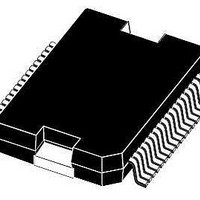L9953 STMicroelectronics, L9953 Datasheet - Page 23

L9953
Manufacturer Part Number
L9953
Description
IC DVR DOOR ACTUATOR POWERSO-36
Manufacturer
STMicroelectronics
Datasheet
1.L9953XPTR.pdf
(38 pages)
Specifications of L9953
Applications
Door Actuator
Current - Supply
7mA
Voltage - Supply
7 V ~ 28 V
Operating Temperature
-40°C ~ 150°C
Mounting Type
Surface Mount
Package / Case
PowerSO-36 Exposed Bottom Pad
Mounting Style
SMD/SMT
Lead Free Status / RoHS Status
Lead free / RoHS Compliant
Available stocks
Company
Part Number
Manufacturer
Quantity
Price
Part Number:
L9953EXP
Manufacturer:
ST
Quantity:
20 000
Part Number:
L9953LXP
Manufacturer:
ST
Quantity:
20 000
Part Number:
L9953LXPTR
Manufacturer:
ST
Quantity:
20 000
Part Number:
L9953XP
Manufacturer:
ST
Quantity:
20 000
Company:
Part Number:
L9953XPTR
Manufacturer:
st
Quantity:
1 699
Part Number:
L9953XPTR
Manufacturer:
ST
Quantity:
20 000
L9953 / L9953XP
4
4.1
Note:
4.2
4.3
Note:
Functional description of the SPI
Serial Peripheral Interface (SPI)
This device uses a standard SPI to communicate with a microcontroller. The SPI can be
driven by a microcontroller with its SPI peripheral running in following mode: CPOL = 0 and
CPHA = 0.
For this mode, input data is sampled by the low to high transition of the clock CLK, and
output data is changed from the high to low transition of CLK.
This device is not limited to microcontroller with a build-in SPI. Only three CMOS-compatible
output pins and one input pin will be needed to communicate with the device. A fault
condition can be detected by setting CSN to low. If CSN = 0, the DO-pin will reflect the
status bit 0 (fault condition) of the device which is a logical-or of all bits in the status registers
0 and 1. The microcontroller can poll the status of the device without the need of a full SPI-
communication cycle.
In contrast to the SPI-standard the least significant bit (LSB) will be transferred first
(see
Chip Select Not (CSN)
The input pin is used to select the serial interface of this device. When CSN is high, the
output pin (DO) will be in high impedance state. A low signal will activate the output driver
and a serial communication can be started. The state when CSN is going low until the rising
edge of CSN will be called a communication frame. If the CSN-input pin is driven above
7.5V, the L9953 will go into a test mode. In the test mode the DO will go from tri-state to
active mode.
Serial Data In (DI)
The input pin is used to transfer data serial into the device. The data applied to the DI will be
sampled at the rising edge of the CLK signal and shifted into an internal 24 bit shift register.
At the rising edge of the CSN signal the contents of the shift register will be transferred to
Data Input Register. The writing to the selected Data Input Register is only enabled if exactly
24 bits are transmitted within one communication frame (i.e. CSN low). If more or less clock
pulses are counted within one frame the complete frame will be ignored. This safety function
is implemented to avoid an activation of the output stages by a wrong communication frame.
Due to this safety functionality a daisy chaining of SPI is not possible. Instead, a parallel
operation of the SPI bus by controlling the CSN signal of the connected ICs is
recommended.
Figure
3).
Doc ID 14278 Rev 3
Functional description of the SPI
23/38













